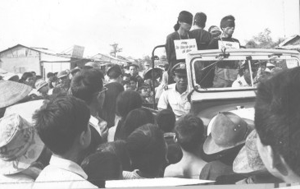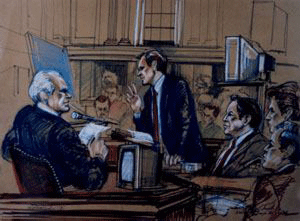Westmoreland and the Plaintiffs at Trial
The trial opened on October 11, 1984 in New York City, and while CBS was officially the defendant in the case, General Westmoreland and his war record were also on trial. In bringing the lawsuit, Westmoreland also invited CBS to present evidence that called into question his actions as commander. After opening statements, Westmoreland’s lawyers called as witnesses a series of former high-level officials who had served in the Johnson administration, including defense secretary Robert McNamara, ambassador to South Vietnam Ellsworth Bunker, White House advisor Walt Rostow, and Westmoreland’s civilian chief of pacification, Ambassador Bob Komer. They testified that there was no  cover-up of enemy troop strength and that President Johnson received the intelligence he needed to make decisions. They also denigrated the fighting capacity of the Communist militia forces at the heart of the order of battle dispute.
cover-up of enemy troop strength and that President Johnson received the intelligence he needed to make decisions. They also denigrated the fighting capacity of the Communist militia forces at the heart of the order of battle dispute.
General Daniel Graham, who was an intelligence officer as a colonel during the Vietnam War, testified on these matters, and also offered opinions about the Tet offensive and the media’s coverage of the battle. Graham argued that the Communist forces at the time of Tet “were literally scraping the bottom of the barrel” by sending seriously wounded soldiers back into combat and pressing into service young villagers who did not know how to fire their weapons. He described the Tet offensive as “an all-out effort” with a total attacking force of “no greater than 85,000.” Graham said that this figure was in line with the under 300,000 total-force estimate reported by Westmoreland. Like his former commander, Graham believed that the U.S. military had won the battle at Tet. He declared: “I believed from the time of the Tet offensive that the communist forces had been militarily whipped in Vietnam,” but that the war had been lost “politically.” He said that the political decision was made to withdraw “just as we were making great headway,” and he claimed that the media had played a role in the political defeat.1
Westmoreland Takes the Stand
The centerpiece of the plaintiff’s case was the dramatic testimony of Westmoreland himself — an imposing figure by all accounts, with his famous jutting jaw and distinguished appearance. Westmoreland downplayed the importance of the order of battle, claiming that he never made use of it. He said the order of battle “was really historic data, and it was not something that was useful to me.”2 The general said he focused on current  intelligence about enemy troop movements and disposition. However, the historical record undercuts the general’s claim that the order of battle was not important. Military and CIA officials held a series of meetings in the months leading up to Tet to hammer out an agreement on the order of battle dispute and much bureaucratic effort was spent in trying to sort out the proper numbers for the enemy.
intelligence about enemy troop movements and disposition. However, the historical record undercuts the general’s claim that the order of battle was not important. Military and CIA officials held a series of meetings in the months leading up to Tet to hammer out an agreement on the order of battle dispute and much bureaucratic effort was spent in trying to sort out the proper numbers for the enemy.
Westmoreland also denigrated the threat posed by the so-called self-defense and secret self-defense militias, the type of irregular forces that CBS alleged the general and his staff had undercounted. Members of these militias defended local villages under Communist control, and carried out a variety of military tasks, including sniping at American and South Vietnamese troops, setting booby traps, laying land mines, and performing auxiliary functions for the enemy’s main forces. Westmoreland said he focused on these main forces because they were “dangerous,” “organized, well equipped units” that posed the greatest threat to his troops.3
The militia units “were really not a threat and they were not dangerous to us because they were confined to the hamlets.”General WestmorelandThe General repeatedly called the militia units “home guard types,” and he said these units were made up of old men, women, and children. Westmoreland said these militia forces “were really not a threat and they were not dangerous to us because they were confined to the hamlets.” Westmoreland acknowledged that these forces “dug fortifications and put in punji stakes” and carried supplies for main force units, but he repeated “they were not a significant military element.”4
However, CBS would call as witnesses common soldiers, CIA officials, and even some members of Westmoreland's own staff who would offer compelling testimony about the casualties caused by land mines and booby traps, the danger posed by apparently friendly villagers who were in fact enemy guerrillas, and the importance of securing hamlets, where the war largely was being fought.
_____________________________________________
1Trial transcript, Vietnam, A Documentary Collection — Westmoreland vs. CBS (New York: Clearwater, 1985), microfiche, 1866-7, 2155-6.
2Trial transcript, 3433.
3Trial transcript, 3421, 3470.
4Trial transcript, 3470.